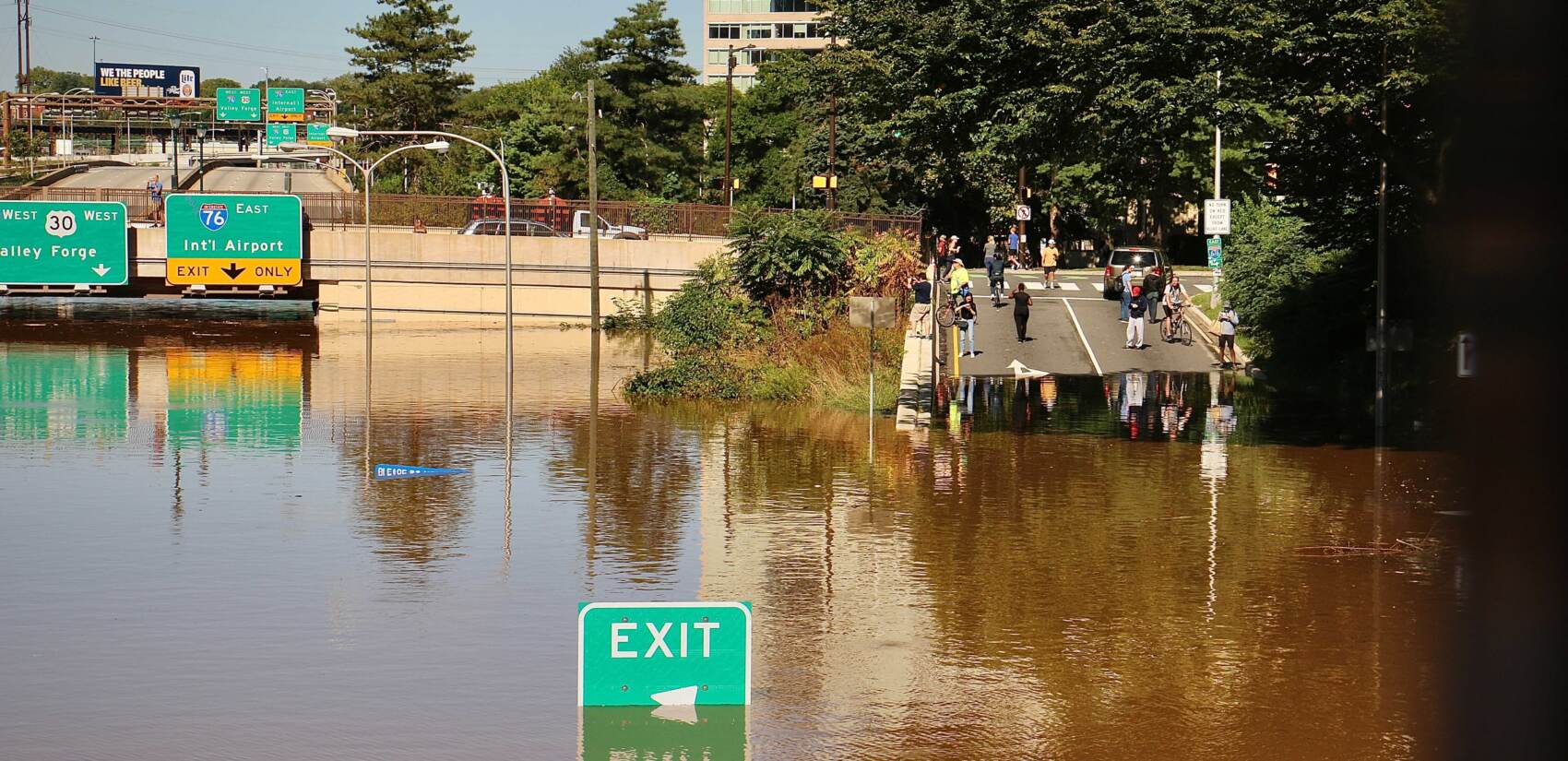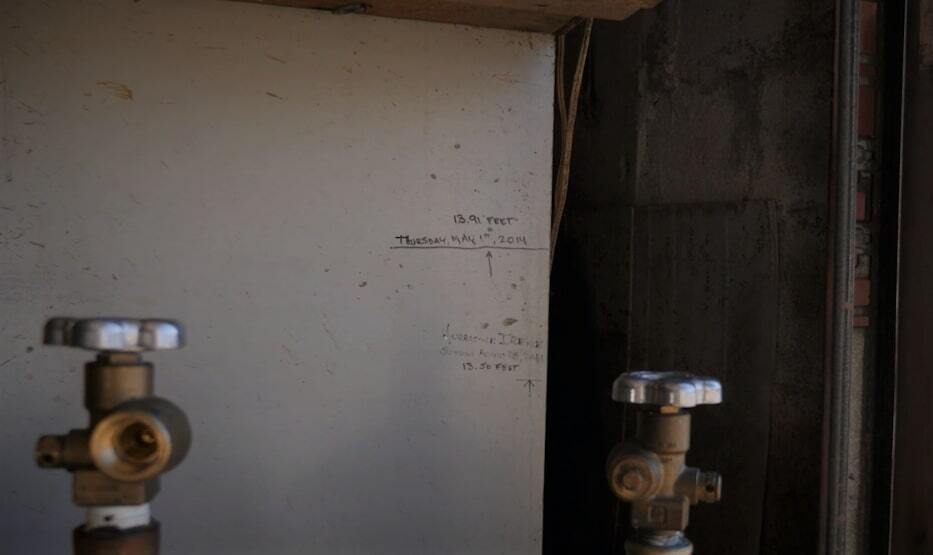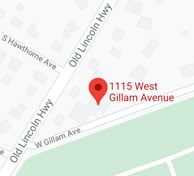When Hurricane Ida struck in early September 2021, the city of Philadelphia really felt the effects of the flooding. Fire Commissioner Adam Thiel stated that the river was at heights not seen in more than 150 years, according to an article by NPR. 
Historic Boathouse Row, which sits right along the Schuylkill River and Kelly Drive, was of course hit hard by the flooding. Where we usually see the charming Boathouse Row lights was the aftermath of a destructive hurricane. And while the members of these boathouses had certainly seen flooding before, this was nothing like they were used to.

John Krajewski, president of Fairmount Rowing Association, was one of many veteran rowers who were unprepared for the damage. As seen in the picture below, Hurricane Irene of 2011 hit the garage of his boathouse about knee or thigh-deep. The storm that hit in 2014 was a bit higher than Irene, but still nothing too damaging. Hurricane Ida, on the other hand, almost reached the top of the garage door. "It ripped structural supports right off the wall," John explained. "The boats actually rose with the flooding and destroyed all the racks."

Not only this, but the water also rose over their air conditioning units, completely frying them. With another hot summer not too far away, John knew he needed to get them replaced. That's where ECI came in.
Want to see an overview of this project? Watch the video below.
History of Fairmount Rowing Association
Considering the extensive history of the association, it's pretty significant that this was one of the highest floods they've ever seen.
Fairmount Rowing Association (FRA), located at 2 Boathouse Row, Philadelphia, Pa., is home to a rowing club that was founded in 1877. They are primarily a Masters rowing club, meaning it is mostly post-collegiate. The once small team started out holding meetings in a room on Fairmount Avenue and was eventually able to purchase a six-oar barge which they stored in an old building. Members had to carry the boat six blocks to the river to row, according to their website. Later down the road in July of 1881, the club purchased the southern half of #2 Boathouse Row from Pacific Barge Club.
When speaking to John about the association's history, he explained how they've been rowing there since the 1800s. "These buildings evolved where there were just boats left on the shore, then they became shacks, to semi-permanent instructors, and finally somebody came in and said 'if you guys are going to put houses here, they're going to have to be constructed properly,' and that's what you see today. There are 15 houses on the river here today."
Want to hear John tell us more about the history of FRA? Watch the video below. 

In 1904, Fairmount tore down their half and had architect Walter Smedley replace it with a two-and-a-half-story brick structure in the Georgian Revival style. And in 1916, the club was allowed to join the Schuylkill Navy after decades of being rejected.
Fast forward to the '40s when FRA purchased the adjacent association, Quaker City Barge Club. The club had fallen on hard times, so under the leadership of John Carlin, the two boathouses were combined to become one association. Quaker City now serves as the northern half of Fairmount Rowing's boathouse. One side was opened up and connected to the other with a bar and kitchen area, which was driven by John Kiefer. They now use the space to host receptions, wedding rehearsals, and other events!
The stained glass windows below represent both Fairmount and Quaker City. The "Wall of Fame" lives to the right of the Quaker City window and features those like Tereza Bell who won the Silver medal in the Lightweight Women's Double at the 1996 Olympics. John also told us about Ted Nash, who was one of the most attended American at the Olympics ever, either as a coach or rower. In between the two windows, the Members in Service are featured. It displays Fairmount Rowing's members that served in World War II. 
It's clear that the history of this boathouse is extensive, and that's why replacing the AC units with new, non-intrusive units that don't damage the boathouse's integrity was important. And, as John stated himself, he and the 150 or so members "row until the river is unrowable". We wanted to make sure that after each long day of rowing, the members could come inside to a cool, comfortable house.
Initial Discussions
After dealing with the damage from the storm, John Krajewski, president of Fairmount Rowing Association, realized the boathouse's HVAC units were affected. While the warm weather was coming to an end for the year and the air conditioning wasn't an urgent fix, it was clear that they would need to be replaced before the upcoming summer.
That's why John called ECI soon after to request a consultation for new ductless air conditioners.
In an older building like this, finding an efficient cooling solution can be tough. To design ductwork or some sort of conventional system to fit in this space without any major renovations is a difficult process. In order to maintain the integrity of the building but still get suitable cooling, the best option was a ductless mini-split.
We landed on replacing the five indoor ductless mini-splits which were re-run to different locations for the five new outdoor condensers. Because all of the previous outdoor units were flooded over -- around six feet high -- we decided that mounting the new ones high up on the opposite wall would be safest. That way, in the event of another flood, they won't be affected.
The Install
Want to see the install in action? Watch the video below.
Relocating the outdoor units
The install crew got started at 8 a.m. the first day to restore the boathouse's cooling comfort. As stated above, they re-ran the lines to connect the indoor air conditioning units to the newly located outdoor units. The linesets are what allow refrigerant to flow through and produce cool air in each room/zone. By moving the outdoor units, we also shortened some of these linesets, which will allow the units to work more efficiently and prevent rooms from overheating. This is especially important for rooms like the bar area, where the combination of the afternoon sunlight and the crowding from guests and caterers causes the room to overheat easily.
Variable-speed compressors
Another benefit of these new units is the variable-speed compressors, which will also help create even, comfortable cooling. Whereas other units waste power by turning on each time you need AC and back off when you don’t, these systems steadily provide cool air to maintain precise temperatures in each room. Take a look at the quick video from Mitsubishi below to get a visual of how it works.
More benefits of ductless
The third main benefit of ductless air conditioning systems is that they are non-intrusive and less complex to install. Rather than doing major renovations to install ductwork throughout the boathouse, all we need are small holes in the wall to run the lines through. In addition, the single-zone units allow for personalized temperature control in each area. If one room is sunnier than the other and needs more cool air, it's no problem with ductless. Take a look at the short video below to how it works.
Completing the installation
Want to see the completed installation + hear more about Fairmount's history? Watch the video below.
Over the course of three days at Boathouse Row, our install crew worked to remove the old units, mount the new ones outside, install the new ones inside, run the refrigerant lines, and connect the power. Installing the linesets included insulating them to prevent condensation on the fittings. If you don’t insulate everything, water can drip out and lead to mold. And the last thing we need inside this boathouse is more unwanted water.
Mounting the outdoor units required securing them to brackets so that they safely stay in space. Placing them high on the wall will keep them out of the way of water, as mentioned earlier, and will also open up more room on the ground where the old units were.
After running the electricity, connecting power to the HVAC system, and testing the system for leaks, the crew was finished with the replacement. Check out the old units versus one of the new condensers below!

We also painted the previously white line-hide to match the blue color of the walls inside, as seen below. This little touch will help them blend in better so that visitors can focus on the memorabilia, trophies, and paintings that keep the boathouse’s history front and center. 
We'll touch base with John and the members of Fairmount Rowing Association this spring/summer to find out how everything is working for them!





